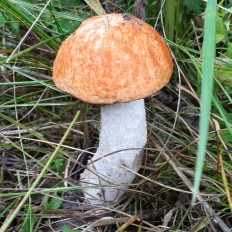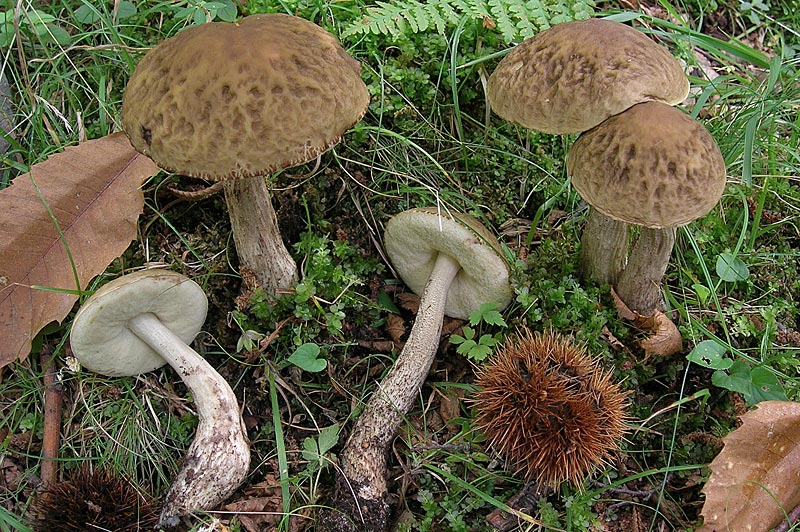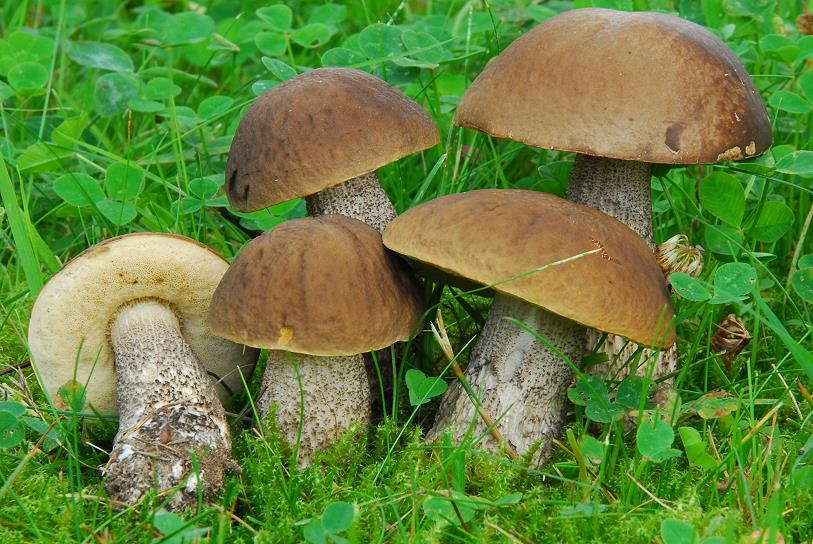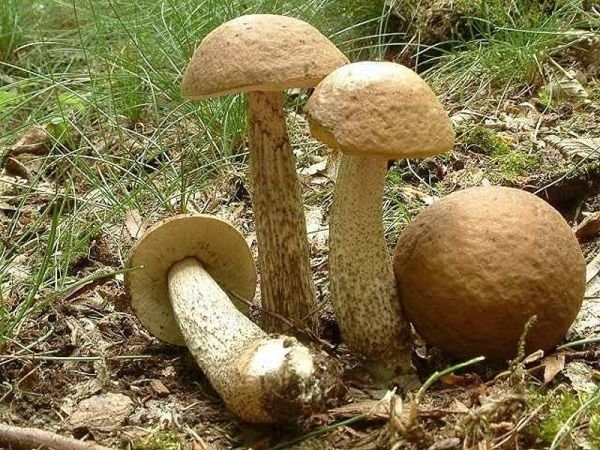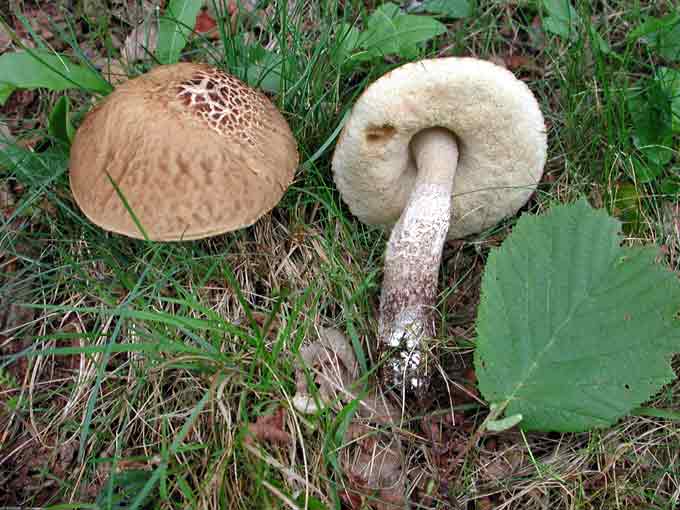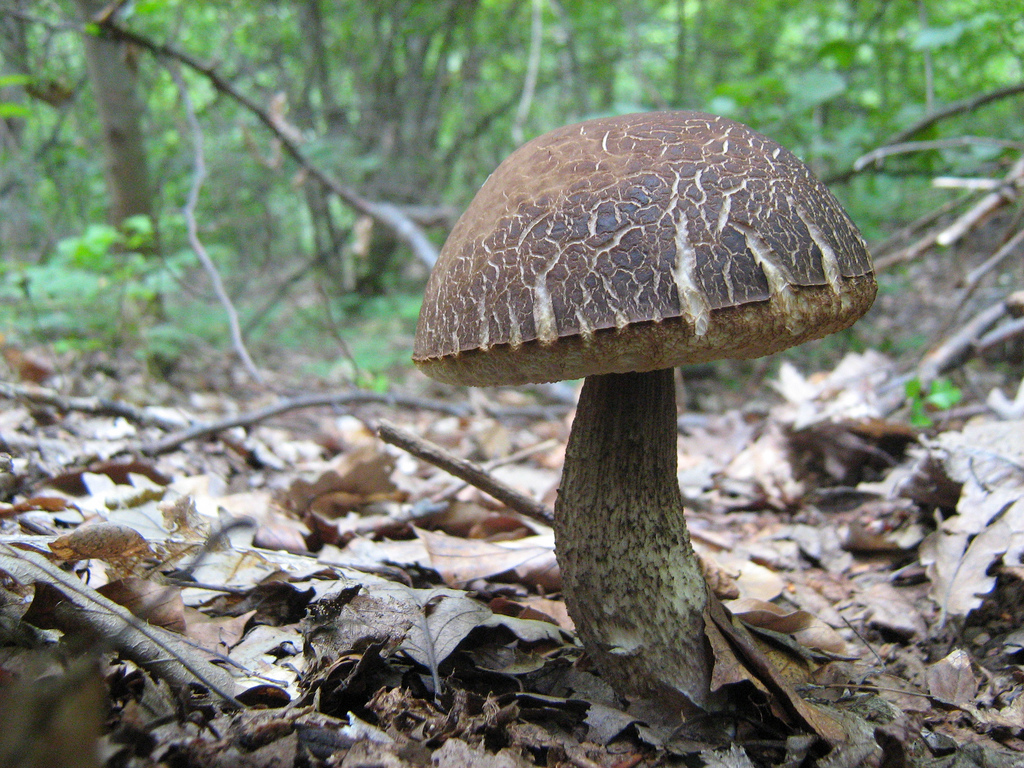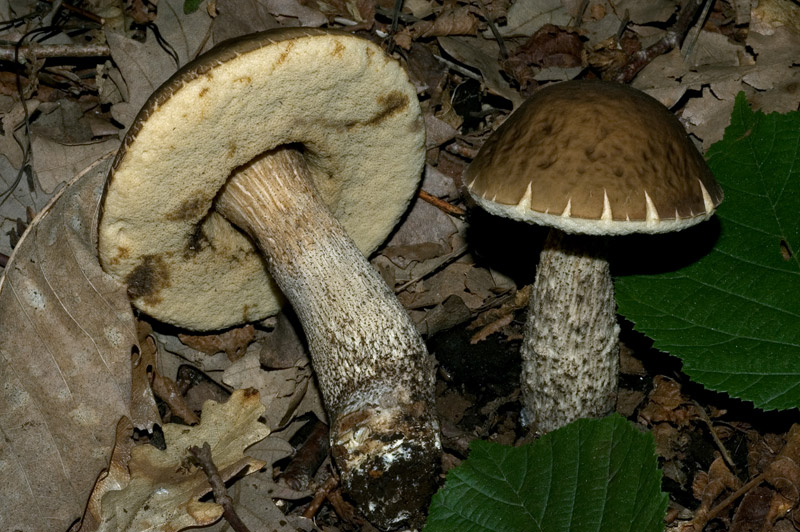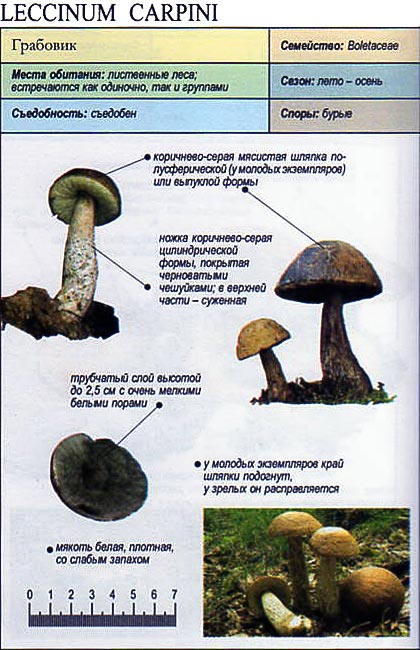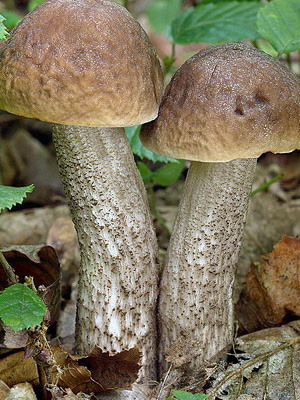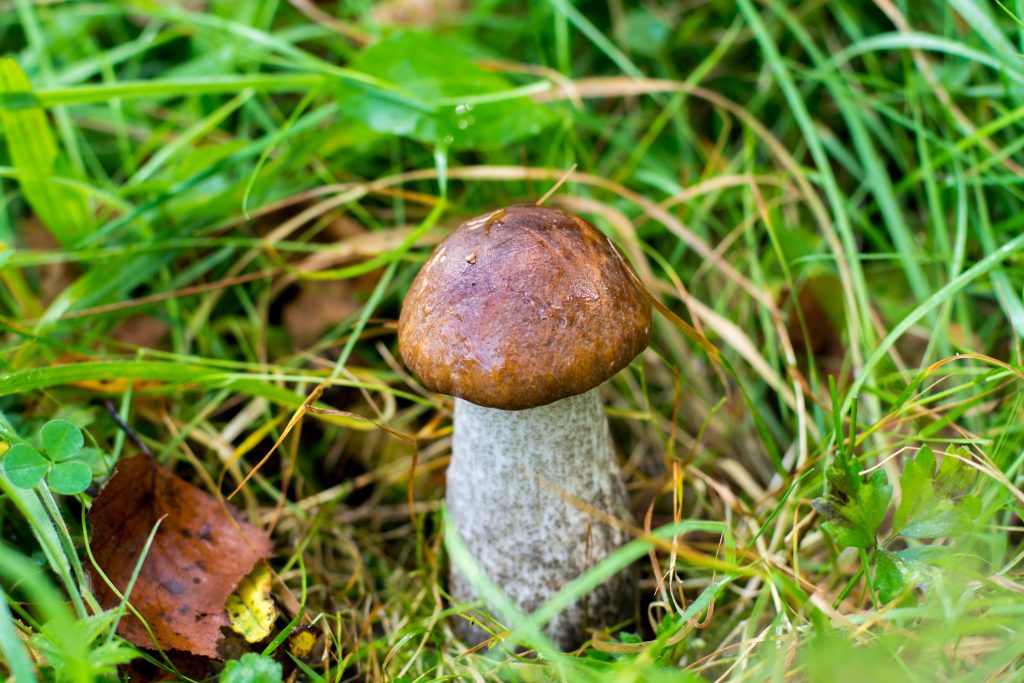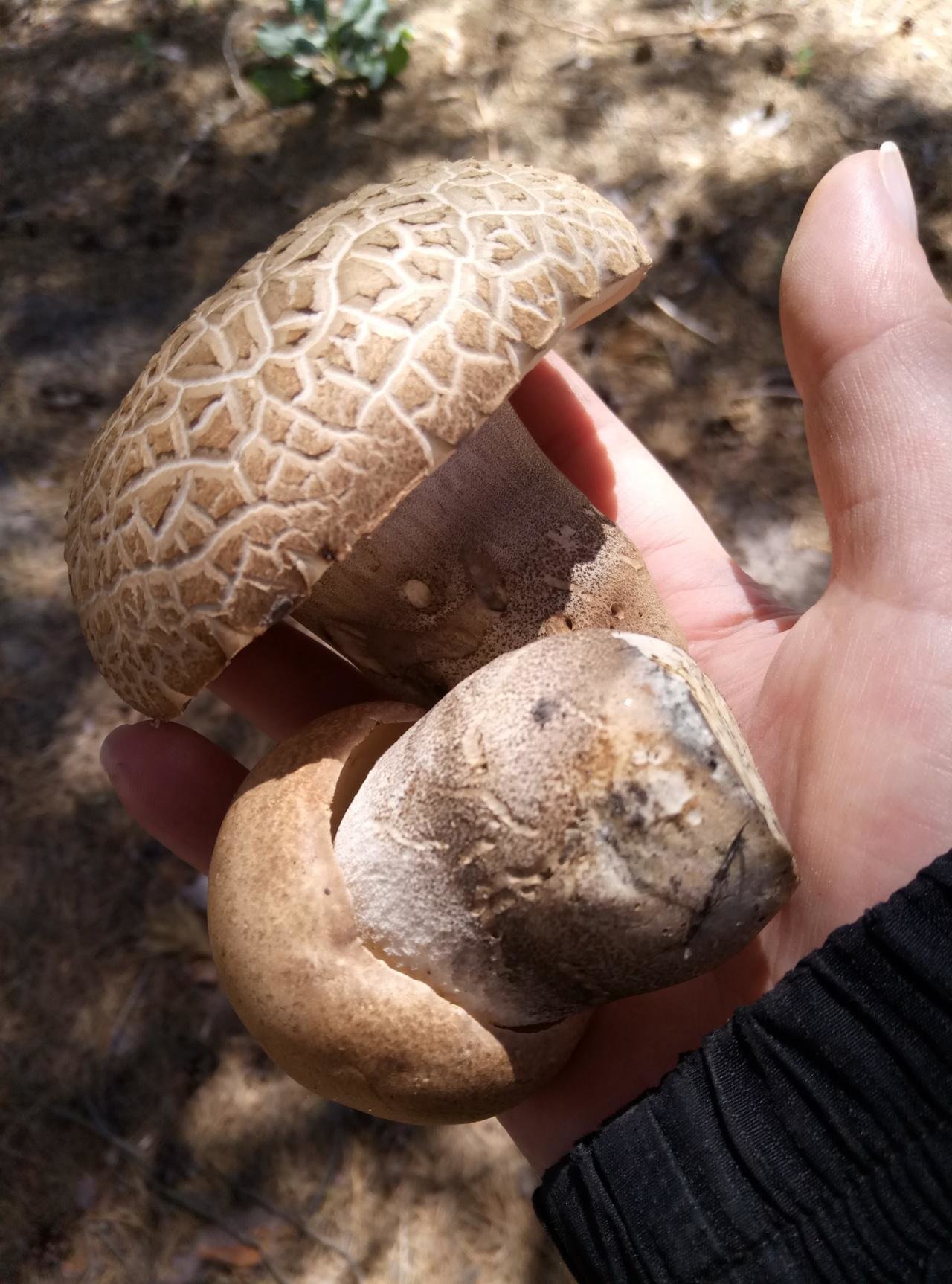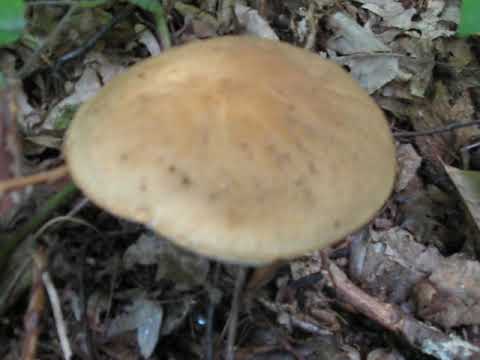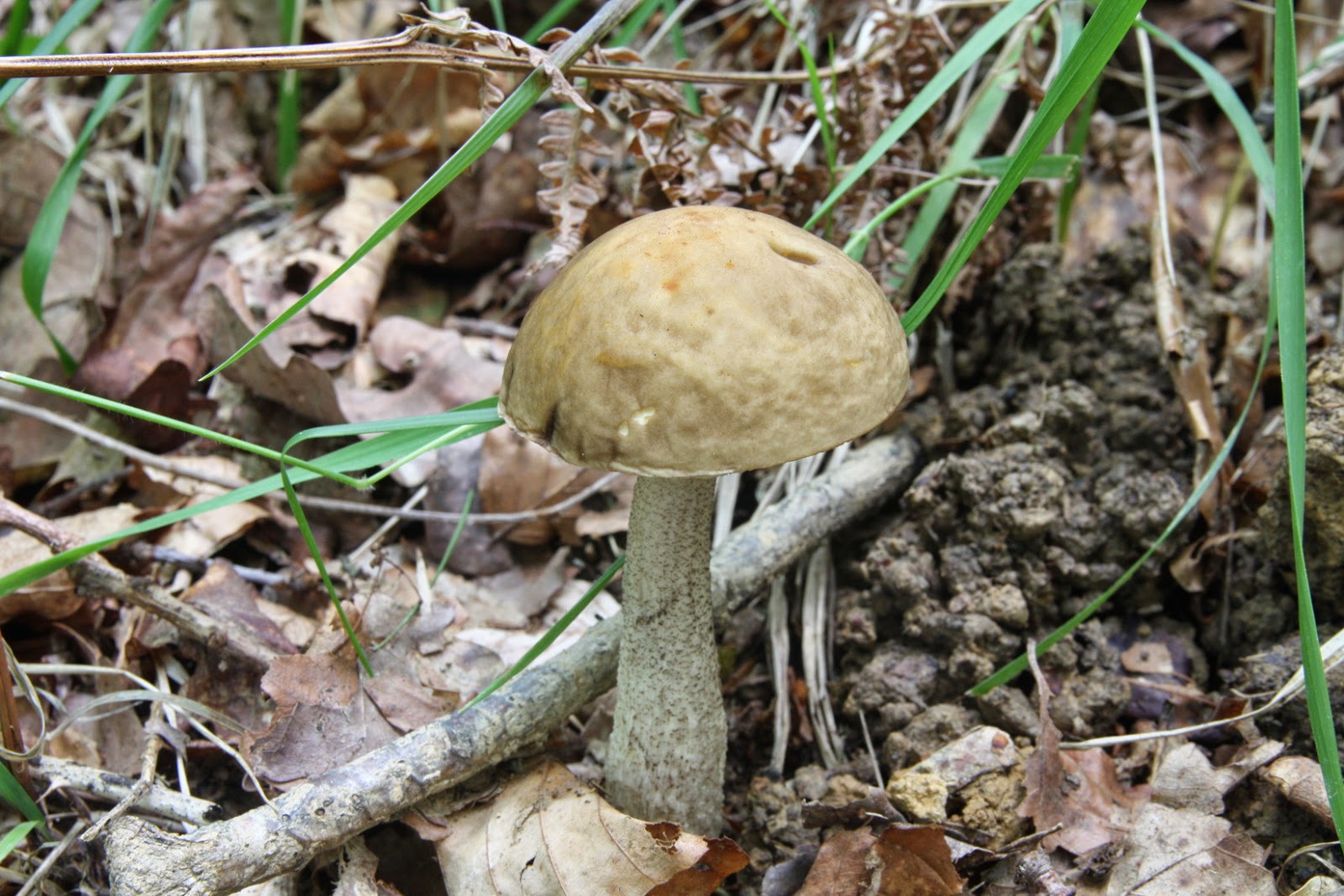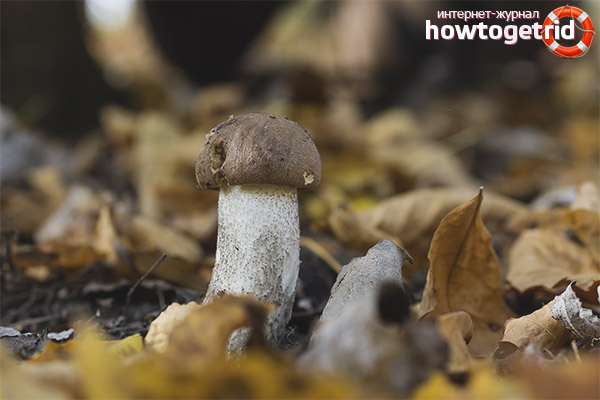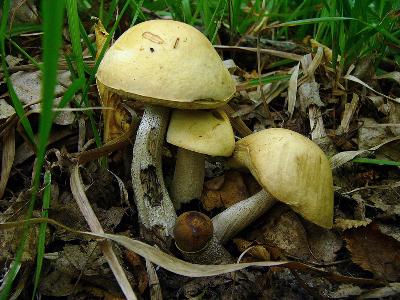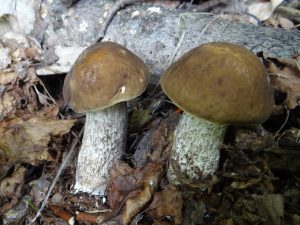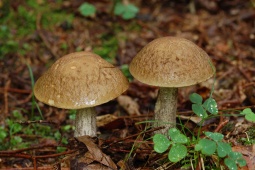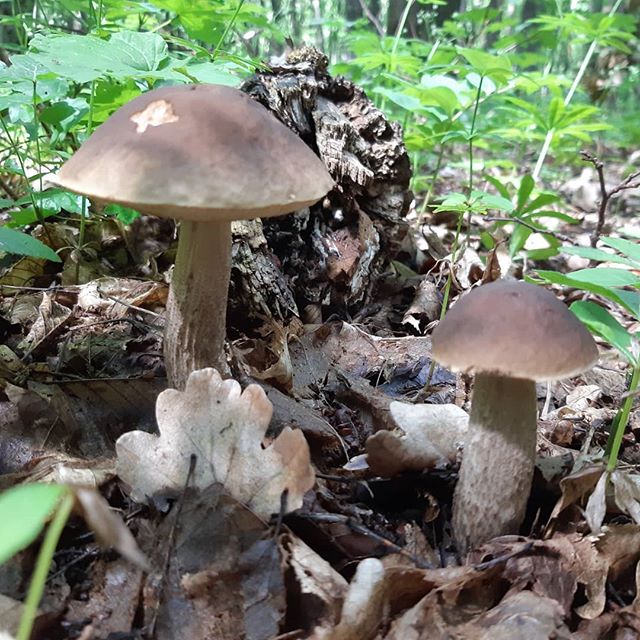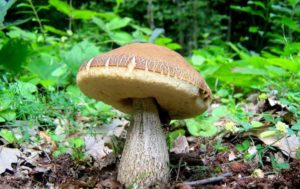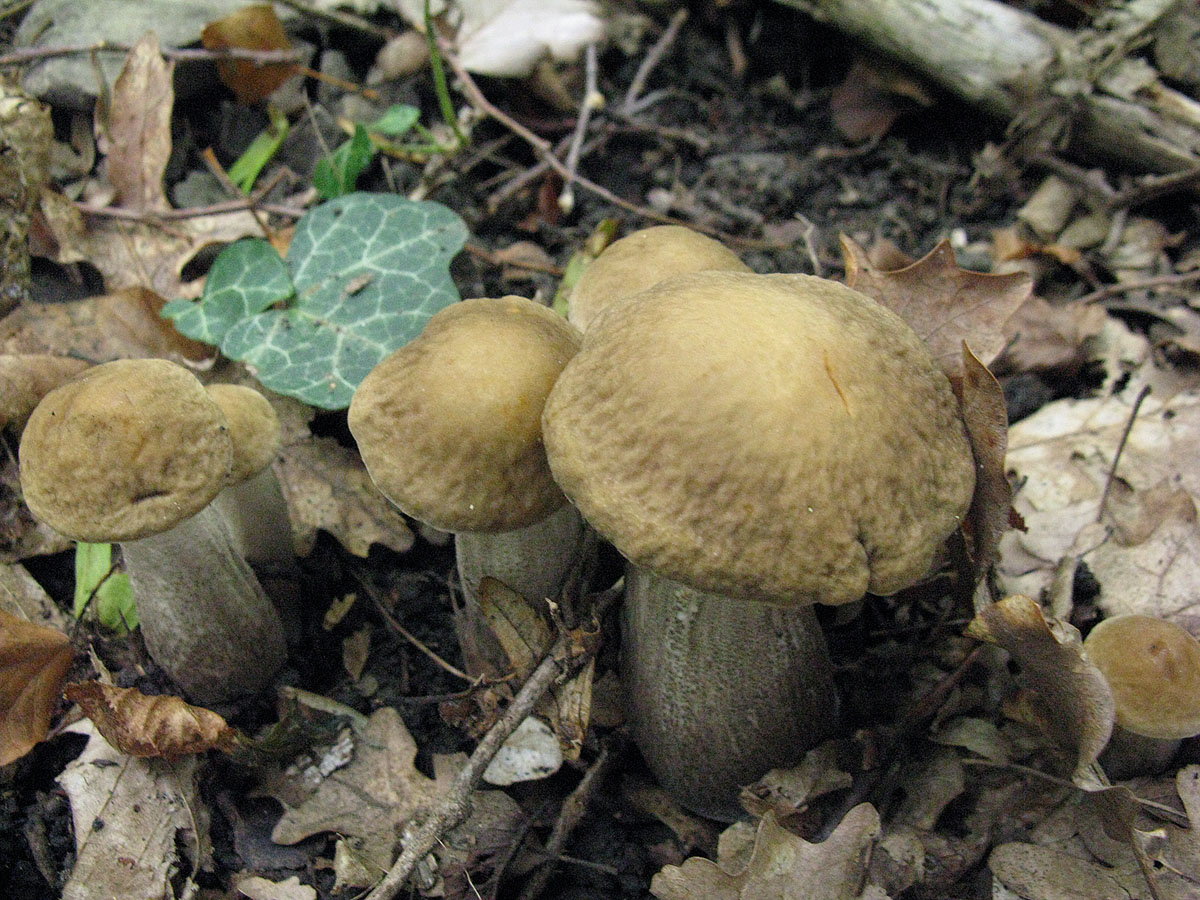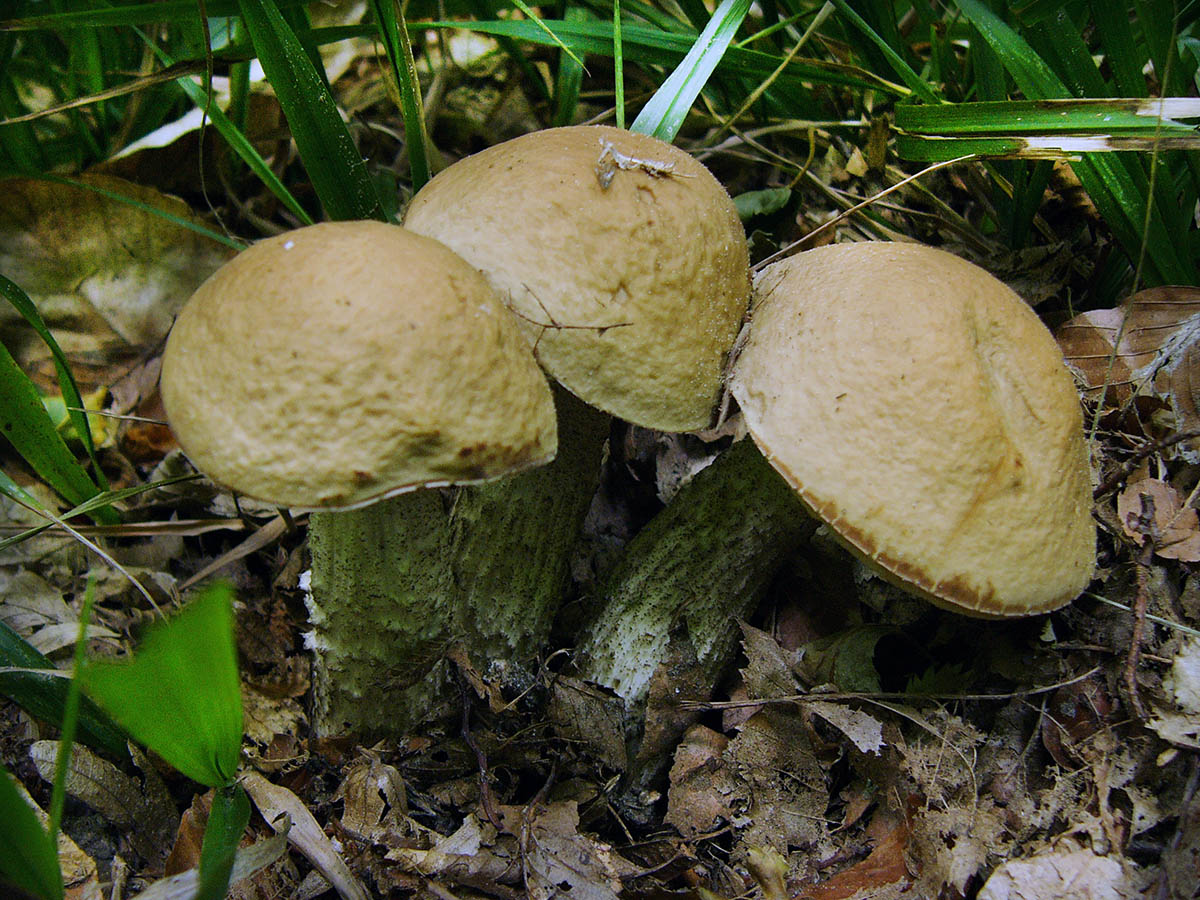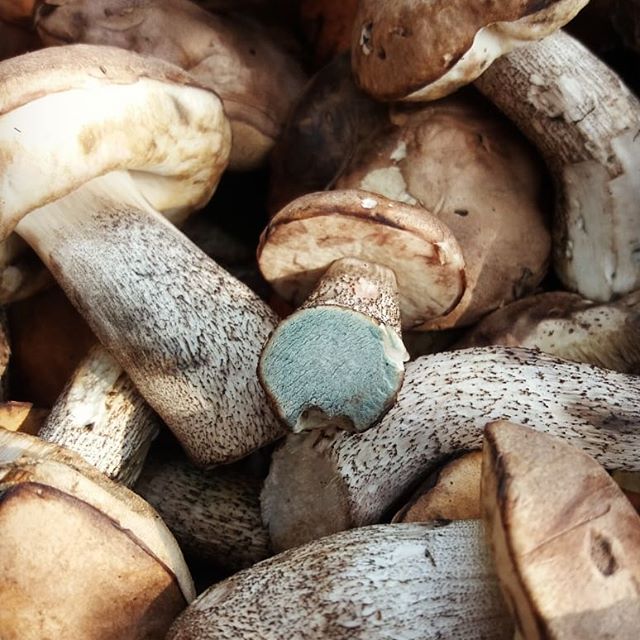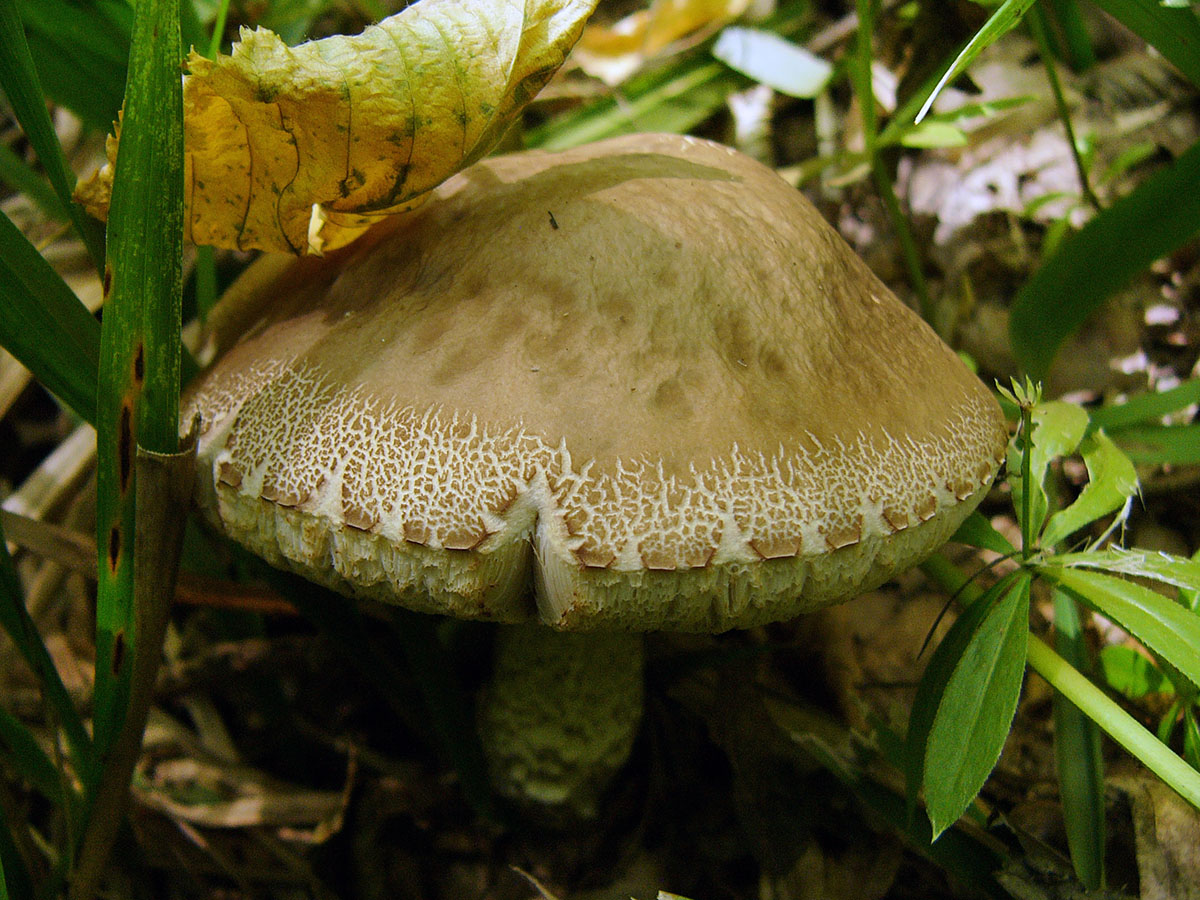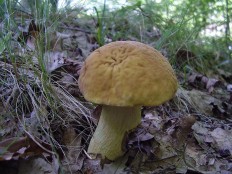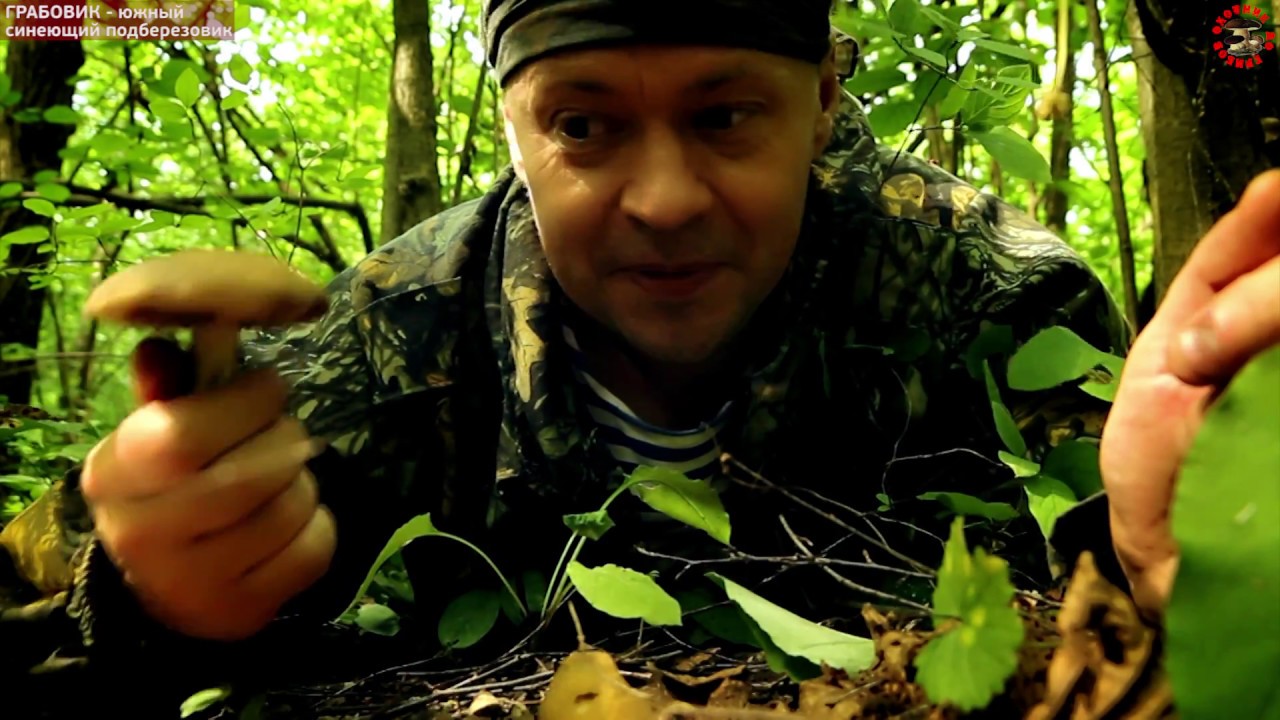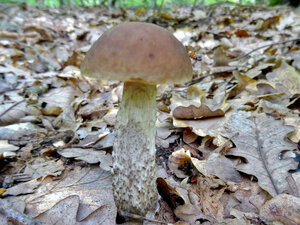Diary of a mushroom picker: the grabber of my childhood

How strange that the most accessible mushroom for me in childhood was the mushroom hornbeam. It is strange, because this type of mushroom is more common in more southern regions than the Smolensk region.
Yes, I didn’t know that it was called that, but they called all these mushrooms - woods. On the outskirts of my grandmother's village a grove of hazel grew, it was clearly man-made, someone was not too lazy to plant hazel bushes on the edge of the forest, the grove stretched from the forest to first houses.
this is how the cakes grew - big families.Photo - Yandex
It was not far to walk into this grove and it was not scary, and under the hazel bushes wonderful shriveled mushrooms grew, similar to slender boletus mushrooms, their cap was all sinuous, the color of coffee with milk.
Sometimes these mushrooms were very fruitful, once in the morning I came to the hazel and saw the space covered with small nuts on the legs. I ran for a basket or a bucket to the nearest house - "Oh, Aunt Masha! Give me a basket - so many mushrooms have grown there!"
Aunt Masha, my friend's grandmother, did not give me baskets, I had to run to my grandmother, to the other end of the village. In short, while I was running, the mushrooms disappeared ..
Wrinkled folded cap - the main difference between the grabovy. Photo Yandex pictures
Naive 8-year-old child, I thought that I could not find that nut, under which there were mushrooms ... Now it is clear - that Aunt Masha herself went for them.
Another story with graboviks from the village. My grandmother was going to Smolensk, but just to go for a drive is not a peasant way, she dug up young potatoes to sell them in the market in the morning, and she told me to collect "podoshnikov".
I ran away a little light, scored, and the mushrooms went to the market, and I was looking forward to grandma's return to find out, well, how? How much money did they give?
Now, little is left of the hornbeam grove, every time I drive past the village I am going to stop by, look - are they there?
Only once did I meet a hornbeam in another forest, but this is understandable, my love for whites and saffron milk caps is not conducive to meeting.
Graboviks love deciduous forests, preferring beech, beech-oak, hornbeam, birch-poplar, that is, not Nashensky, Smolensk.
The brother of the boletus is a grabovik. photo Yandex pictures
In the suburbs of Moscow, the hornbeam is found, judging by the reports in the forum "Mushrooms They Speak", in principle, this mushroom is a kind of boletus, gray boletus (Leccinum carpini),differs from boletus boletus in wrinkled cap and staining of the cut in violet, and then in almost black color, like in boletus boletus.
Good edible mushroom, like all Lecciniums.
Thanks for reading!Subscribe if you like forest and mushrooms!
The mushroom picker's diary is here
Grabovik
Grabovik is an edible mushroom that is a type of boletus. It got its name, which is quite logical, because of the abundant addiction to grow among hornbeams. It also has other names, such as elm boletus, gray boletus, gray boletus. Widespread in the Caucasus, where it prefers deciduous forests, most of which are birches, hornbeams and poplars. It is mainly found singly, but it can grow in rather huge groups. The growing season falls in mid-August and the mushroom bears fruit until relatively significant temperature drops in October. Worth noting is his good growth performance. If you find a place where the hornbeam grew earlier, then after the rain for several days, its new persons will appear here. The mushroom is used abundantly in cooking as a stand-alone dish or as an ingredient in other more sophisticated dishes. However, the slightly friable pulp reduces its nutritional value.The rake is suitable for both pickling and drying. It is categorically impossible to eat raw pulp, since you can get poisoned. Pleasant taste and smell attract many larvae and pests, which is why the mushroom can often be spoiled.
Description. The fruiting body of the caps is pectoral. In the early stages of growth, the cap has a hemispherical shape with slightly curled edges. Over time, the cap becomes prostrate, cushion-shaped, reaching a diameter of 6-14 cm. The skin on the surface is uneven, wrinkled, with high humidity, sticky and sticky. In mature specimens, it often cracks. Often, the skin shrinks, exposing a porous layer. Among the flowers, ash-gray, olive-brown or ocher tones prevail, brown, almost black shades are slightly less common. When cut, a soft white flesh is observed, which quickly darkens, becoming first pink, and then almost black. The tubular layer can reach three centimeters. Tubules are narrowed, white, not more than 2.2 cm in length. Gives off white spore powder. The cylindrical leg is characterized by fibrous pulp and clavate shape. It grows up to 13 cm in height and 4 cm in thickness. With aging, the leg becomes covered with scales. At first it has a whitish yellow color, but soon becomes dark brown. The aroma is pleasant, mushroom.
Grabovik - description, where it grows, the poisonousness of the mushroom
The hornbeam is so named after the hornbeam tree, near which it most often grows. But he also has other names - gray or elm boletus, gray boletus. This mushroom is so similar to the boletus that mushroom pickers cannot always distinguish them.
Appearance characteristic
The hornbeam belongs to the bolet family. His family is obabok.
In young mushrooms, the shape of the cap is hemispherical, with tucked edges. At a more mature age, the cap takes on a cushion shape. The surface is slightly wrinkled, has irregularities. The porous layer is up to 3 cm. The skin is matte and dry, but if it rains, it immediately becomes shiny and looks watery. Therefore, in comparison with the boletus, it loses due to the not such high-quality density of the cap. If the mushroom is overripe, the skin shrinks completely, and then the flesh of the cap, as well as the tubules, are noticeable under it.
The flesh of a young specimen is usually white and soft. But the older generation of hornbeams acquires stiffness with age, which differs significantly from the boletus. When the mushroom is cut, it darkens to a pink-purple color and then turns dark gray. But the aroma and taste of the mushroom are pleasant.
The color of the leg is grayish, but below it changes to brownish. It has a cylindrical shape, which becomes thicker closer to the ground. The pulp in it is fibrous. The thickness of the leg is on average 4 cm, the height is from 5 to 13 cm. The porous layer is free. It has a small notch located at the leg.
The shape of the spores is fusiform, and the spore powder has a brown tint. The pores are very small with an angularly rounded shape, their surface is white or sandy. The tubes are narrow, have a soft consistency with a watery structure.
Where can you find a grabber
Of course, where hornbeams grow, you can also find a hornbeam. But since these trees belong to the genus of birch, gray boletus are often found in birch groves. These mushrooms also grow near other deciduous trees, for example, it can be hazel and poplar.
The most common habitats are the northern zones of Russia and Asia, the Caucasus. You can collect the grabber already in June, and its collection ends in October.
Grab set as food
This mushroom is ranked as edible, and in terms of taste it is very similar to boletus. But due to the fact that its pulp is less dense, it cannot be stored for a long time, it quickly deteriorates.
These mushrooms are especially fond of worms, so many should not be eaten due to the fact that they turn out to be eaten. After collection, you should carefully sort them out at home and leave only fresh and healthy ones.If some parts are darker in color, then this may be evidence of decay, which is dangerous not only for health, but also for life.
Grab is used fresh to fry and boil, dried, soaked in vinegar and salt, pickled. For the preparation of various dishes, recipes are used that are applicable to boletus.
Similar mushrooms
The hornbeam has a similarity (and quite a lot) both with some edible mushrooms and with those that are dangerous to humans.
The gall mushroom is also a double of the hornbeam, but this is already its "antipode", as it is considered almost poisonous. It is not suitable for food because it tastes bitter. Even if you try to get the bitterness out of him, nothing will work, it will only intensify. Such mushrooms most often grow in forests with coniferous vegetation, as well as on sandy soils. Their time of existence is from July to October. Their cap is convex, with an average diameter of 10 cm. In the gall fungus, the surface of the cap is smooth and dry. The color is brown or brown. The pulp is white, thick. When cut, it takes on a pink tint. It has no smell, but you should not try it: it is very bitter. The leg can be up to 7 cm in length, from 1 to 3 cm in width. It differs in that it is swollen and dark brown or creamy-buffy, a mesh pattern is visible.
Grabovik or gray birch tree. A short description of a good mushroom

Brown birch trees in Russia are considered one of the most common mushrooms. The term "birch trees" unites several closely related species of the Boletaceae family, from the genus Leccinum, or limbs.
Most often, representatives of this mushroom family can be found in mixed or deciduous forests, where birches predominate. More often, and even often, but by no means always!
Grabovik (Leccinum carpini).
It is an edible tasty mushroom that forms mycorrhiza with hornbeam (sometimes with hazel, elm or poplar). Other names: gray boletus, gray boletus, elm boletus.
WHAT IT LOOKS LIKE:
Cap: up to 15 cm in diameter, in young mushrooms it is semicircular, with age it becomes flatter, cushion-shaped.
The skin is velvety, wrinkled, dry, matte. The color is very variable: olive brown, ashy, ocher or gray-brown.
Tubular layer: watery, loosely separated from the pulp, sandy gray in color. A notch is visible in the area of contact with the leg
Leg: 15 cm high, up to 3 cm thick, cylindrical, clavate, sometimes slightly narrowed towards the cap.
The main color of the leg is whitish or yellow-gray, dotted with gray, brown and almost black dotted scales.
Flesh: dense, elastic in the cap, soft in maturity, fibrous in the stem. On the cut, it is painted first in pink-purple, then in gray, almost black. The taste is pleasant, slightly sweet, mushroom, and the smell is inexpressive.
SPREAD:
Is growing from June to October, in deciduous forests, preferring beech, beech-oak and hornbeam, often found under hazel.
SIMILAR TYPES:
It is very similar to the common boletus (Leccinum scabrum), which does not change color when cut, and also to the hard boletus (Leccinum duriusculum), which grows only under the white poplar and aspen.
EDIBILITY:
Grabovik is a good edible mushroom. It is used in the same way as other types of boletus. The food can be eaten boiled, stewed and fried. It is also used to make mushroom sauces. For blanks, it can be dried and pickled.
FROM THE AUTHOR:
I wanted to write that it can still be salted. For, going to any website or channel on the Internet, they always and everywhere write about boletus and aspen mushrooms, that they can (need?) Be salted for the winter….
I do not know exactly what the authors of these Internet resources are guided by. Maybe they just stupidly copy each other, without delving into the essence. Or maybe all types of lamellar mushrooms died abruptly in the Russian forests, and I did not know about it ?!
Although, I spend almost half my life in the forest.Or maybe our forests are different? Or an idea of which mushrooms need to be salted, and which ones are better to use in boiled, fried, etc. types?
I do not know the answer to these questions. And, it seems to me very suspicious, on these sites, recipes salting boletus, boletus and even porcini mushrooms. For me, it's like spinning fish in my home aquarium!
AND MUSHROOMS YOU FULL BASKETS! EATABLE!
Evaluation of the edibility of hydnellum odorous
These mushrooms have no culinary value, they are inedible.
The medicinal properties of odorant hydnellum
These are antioxidant mushrooms. In 2006, studies were carried out and the antioxidant activity of odorant hydnellum was revealed. These mushrooms contain substances that have the same activity as α-tocopherol.
Related species
Hydnellum Peka is an inedible type of mushroom. It is also called the devil's hedgehog and the bleeding tooth. It looks delicious, like chewing gum with drops of raspberry syrup. This fluid forms inside the fruiting body and oozes out of the pores. The surface of the fruiting body is white, later it may turn beige or brown. The diameter of the mushroom is 5-10 centimeters.
Hydnellum Peka can be found in coniferous forests. They grow in North America and Europe. These mushrooms have antibacterial properties. This is a special mushroom - it can feed not only on juices from the soil, but also on insects that fall on the surface of the fruit body.
Gidnellum blue is an inedible mushroom. The hat is large - its diameter can reach 20 centimeters, and its height reaches 12 centimeters. Above the hat is light blue, and the lower part is darker. The cap has small spines, the length of which is about 4 millimeters. The surface of the mushroom is uneven and bumpy, slightly velvety. The leg is short, half immersed in the moss. The color of the leg is brown. The pulp is without a special smell, tough in consistency.
Gidnellum blue prefers to grow in pine forests located in the northern part of the European hemisphere. They like to settle in sunny places with white moss. Almost always, these mushrooms grow singly, only sometimes they gather in small groups. Fruiting is observed from July to September.
Description of the grabber
The diameter of the cap ranges from 7-14 centimeters. The shape of the cap in young mushrooms is hemispherical, while the edges are tucked up; over time, the shape of the cap changes to cushion. The surface of the cap is uneven, slightly wrinkled. The skin is dry and matte, and in wet weather conditions it becomes shiny.
The color of the cap is olive-brown or gray-brown. If the mushrooms are overripe, the skin may shrink, exposing the flesh of the cap and tubules. The flesh is white, soft, but fibrous in the stalk, while in older specimens it is tough. When cut, the flesh turns pink-purple in color, and then turns gray, almost black.
The porous layer is free; there is a recess in it near the stem. Fusiform spores. The tubules are narrow, soft, slightly watery in structure. The pores are small in size with a sandy or whitish surface, angularly rounded.
The stem is cylindrical in shape with a wider clavate base. The height of the leg reaches 5-13 centimeters, and the width reaches 4 centimeters. The upper part of the leg is olive-gray and the lower part is brownish. The surface of the leg is covered with scales, the color of which changes as it grows: at first it is light yellow, and then it becomes dark brown. The spore powder is brown in color, and the spores themselves are fusiform.
Growing places of a grabovy
They grow in deciduous forests, mainly hornbeam. These mushrooms form alliances with the hornbeam. Also hornbeams can create mycorrhiza with hazel, birch and poplar, but with these trees alliances are formed much less often.
On the territory of our country, hornbeams are found in the regions of the Caucasus. Harvesting begins in June and lasts until October.
Eating a hornbeam
Grabovik is an edible mushroom, in taste it is similar to boletus boletus, but it is less valued, since its pulp is not too dense, which prevents mushrooms stored for a long time.
Similar species
Edible similar species include boletus. The boletus cap can be of various colors - from whitish to almost black. The leg is thickened at the base, has an almost white color. Dark or white scales are located over the entire surface of the leg.
Boletus is a twin of a grabovik
Boletus mushrooms create mycorrhiza with birches, so they are found in birch forests and groves. In addition, they can grow in forest-tundra and tundra. Boletus fruiting occurs in early summer and continues until autumn. These mushrooms can be eaten, but after heat treatment. They are fried, boiled, pickled and dried.
And the inedible double is the gall mushroom. This mushroom is not edible due to its bitter taste. During cooking, the bitterness does not disappear, but, on the contrary, becomes stronger. Bile fungi grow in coniferous forests, most often on sandy soils. They are found from July to October.
Gall mushroom, it is also easy to confuse with a grabber
A gall fungus can be recognized by a convex cap with a diameter of 10 centimeters. Its surface is dry and smooth, brown or brownish in color. The flesh of the gall mushroom is thick, white, when cut it turns pink. It is odorless and tastes very bitter. The leg is 7 centimeters long and 1-3 centimeters wide. The leg is swollen, dark brown or creamy buffy with a mesh pattern. The tubular layer is initially white, and then becomes a dirty pink color. Spores are smooth, fusiform, pink spore powder.
11156 Article rating by Kira Stoletova
The pleasant-tasting mushroom hornbeam is used in many areas. It has similar characteristics to the common boletus, but differs in a more brownish hat. They appreciate it for its abundant fruiting and useful qualities. It is heavily damaged by larvae.
Mushroom hornbeam
Growing
The cultivation process is similar to the cultivation of porcini mushrooms. But the yield of gray boletus is distinguished by the best indicators. The optimal time for sowing is from May to the end of August.
Process steps:
- Prepare the site, remove the garbage.
- Around the birch, holes are dug under the "seeds" 20 cm deep and 10 cm in diameter. The tree must be at least 4 years old, otherwise the beginning of fruiting will be delayed.
- The holes are filled with a mixture of soil and peat.
- Lay a piece of compost mycelium and cover it with earth.
- Ramp down.
To increase fruiting, you should properly care for the mycelium. In the dry season, it is necessary to ensure soil moisture by sprinkling. For this, a spray bottle is used. Water the garden in the afternoon so that direct sunlight does not fall on it. Low herbaceous plants are often planted nearby. They do not interfere with the penetration of light, but they can create protection from the sun.
Top dressing can increase yields. Funds are bought in a specialized store. Apply according to the instructions. With the onset of cold weather, the site is covered with straw, spruce branches, fallen leaves, moss. When it gets warm, the protection is removed.
Mushrooms appear in the first year of cultivation. From 5 to 15 fruit chalk grows around the tree. The highest fruiting occurs 2 years after planting. After 5 years, the amount of the crop decreases.
Main types
Common boletus (Leccinum scabrum)
Common boletus (Leccinum scabrum)
The best appearance of this group is characterized by a smooth hemispherical cap with a diameter of up to 15 cm. The peel is chestnut with a grayish, black or reddish tint, in young mushrooms it is light. The leg is up to 20 cm high, slender, wide at the base, the surface is mottled with a scaly dark pattern.
The pulp is grayish-white, then gray, does not darken at the break, at first it is hard, then soft, porous. The structure is spongy in rainy weather. Pleasant taste, mushroom aroma.
Marsh boletus (Leccinum holopus)
Marsh boletus (Leccinum holopus)
A tall mushroom with a very light, almost white convex cap, up to 15 cm in diameter. The skin is thin, sometimes greenish or brown in color. The stem is long, refined, often curved, cap color or brownish. The tubules are whitish-cream, then brownish, turn green when pressed.
The pulp is creamy, later with a yellowish-green tinge, does not darken when broken, watery, fresh in taste, with a slight mushroom aroma, often odorless.
Harsh boletus (Leccinum duriusculum)
Harsh boletus (Leccinum duriusculum)
The fleshy strong species rarely turns worm, and for this quality we are especially fond of mushroom pickers. The cap is up to 15 cm in diameter, hemispherical, then convex, concave in older specimens. The skin is velvety at first, then smooth, matte, in damp weather - slippery, light chestnut, with a red glow, often with a lilac tint. Leg up to 15 cm high, cylindrical, thickened in the center, cream-colored, covered with a reticular scaly pattern.
The tubules are creamy, and greenish-brown when touched. The pulp is tight, white-creamy, at the leg it is greenish-yellow, on the broken cap with a pink tint, when cut at the very leg it turns green or blackening. The taste is neutral, the aroma is pleasant, mushroom.
Boletus varicoloured (varicoloured boletus) (Leccinum variicolor)
Boletus varicoloured (varicoloured boletus) (Leccinum variicolor)
Externally and in culinary use, the species is similar to boletus boletus. The cap is variegated - brown with whitish-gray spots and stains, sometimes the main color is brown, almost black, reaching a diameter of 15 cm. The stem is brown, cylindrical, even, turns green at the base.
The tubular layer is off-white with a bluish tinge, darkens when pressed. The pulp is creamy white, when broken, it acquires a pink tint, at the leg - red or green. The structure is watery, the taste is fresh, the smell is light, mushroom.
Pink boletus (Leccinum roseafractum)
Pink boletus (Leccinum roseafractum)
The hemispherical cap eventually becomes cushion-shaped, reaching a diameter of 12 cm. The skin is yellowish-brown or brown, often spotted, with light streaks. The leg is low - up to 10 cm, sometimes curved, the surface is light, with a black-brown scaly pattern.
The tubes are creamy, turning pink when pressed. The pulp is tight, light creamy, turns pink when broken, later becomes dark. The smell is insignificant, the taste is simple.
Boletus gray (hornbeam) (Leccinum carpini)
Boletus gray (hornbeam) (Leccinum carpini)
Appetizing mushroom with a round cap up to 15 cm in diameter, which is hemispherical at first, then cushion-shaped, later flat. Skin color in brown-gray tones - from light gray to brown, olive, black, in the center at the edges - yellowish. The surface is velvety, first wrinkled, then matte, cracked in heat, slippery in wet weather.
The leg is high - up to 16 cm, thickened at the top, the surface is light, darkens when pressed, speckled with black scales, which later become brownish. The tubules are white, creamy gray, brown or purple when pressed.
The pulp is whitish with a yellow tone. At the break, it acquires a deep pink or red color, and later becomes black.
Black boletus (blackhead) (Leccinum melaneum)
Black boletus (blackhead) (Leccinum melaneum)
Squat appearance with a dark brown hemispherical cap, then convex, up to 10 cm in diameter. The leg is up to 12 cm high, even, brown or grayish, abundantly speckled with darker scales. The skin is velvety, then matte, in dampness - sticky.
The tubules are large, creamy or grayish-white. The pulp is tight, white, does not darken or slightly blue when broken. Mushroom aroma, neutral taste.

